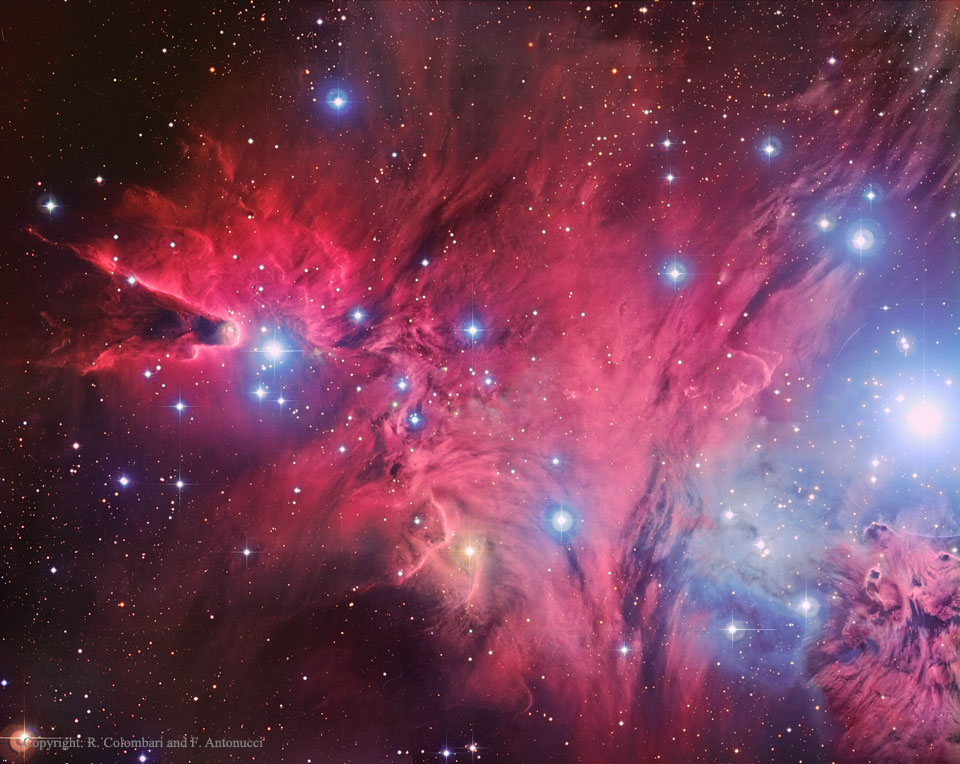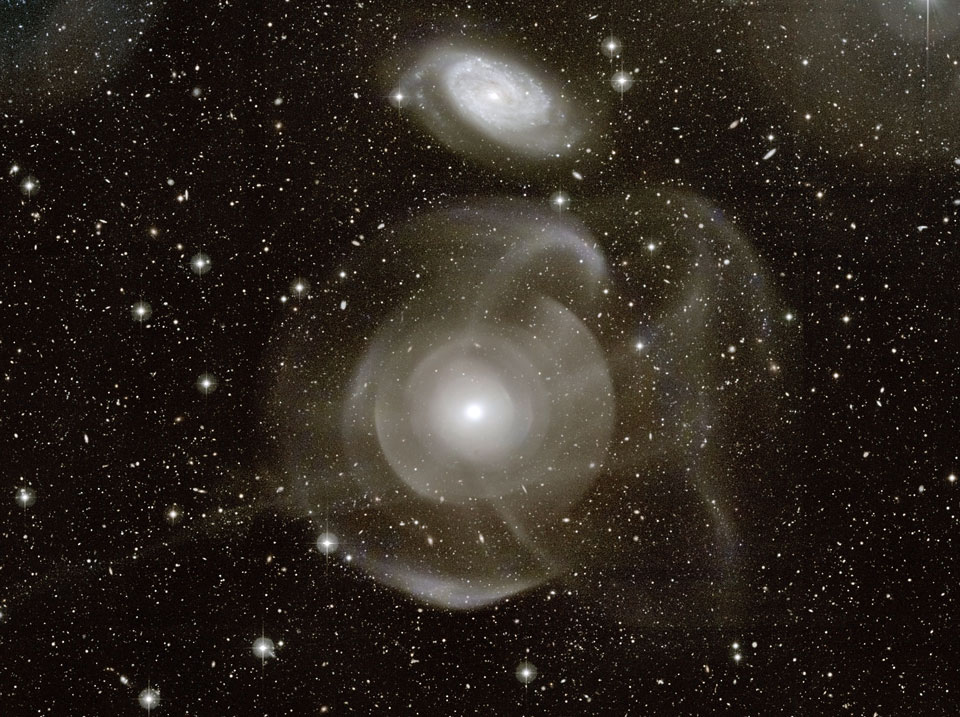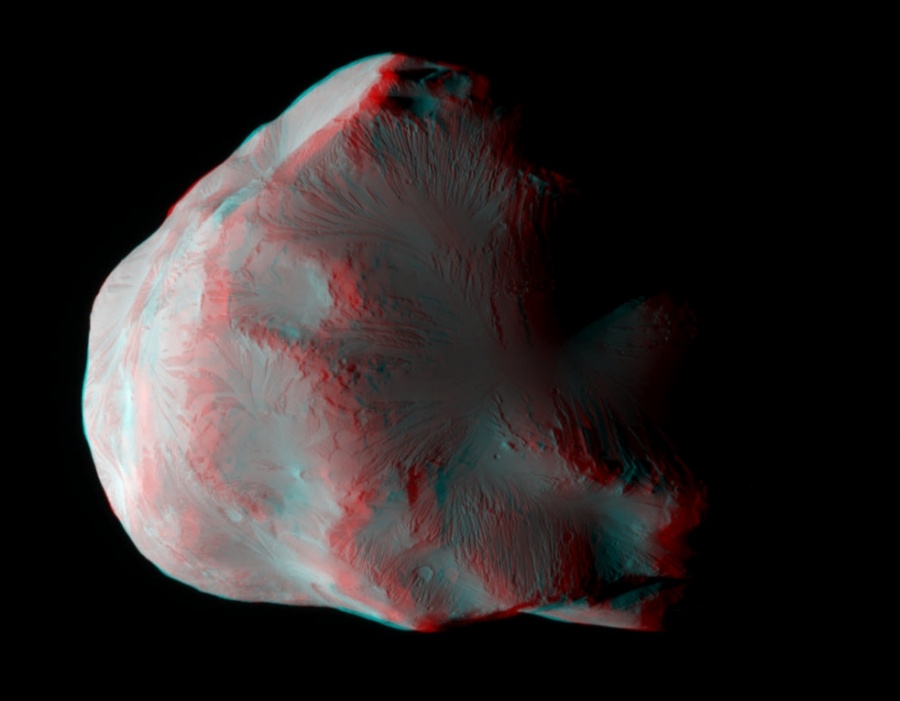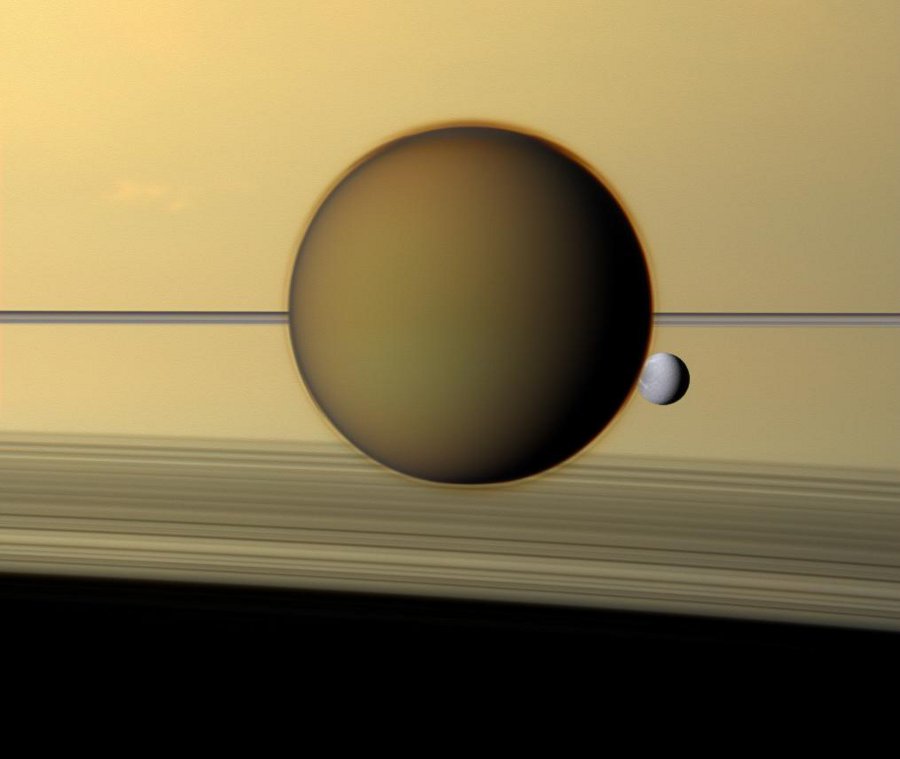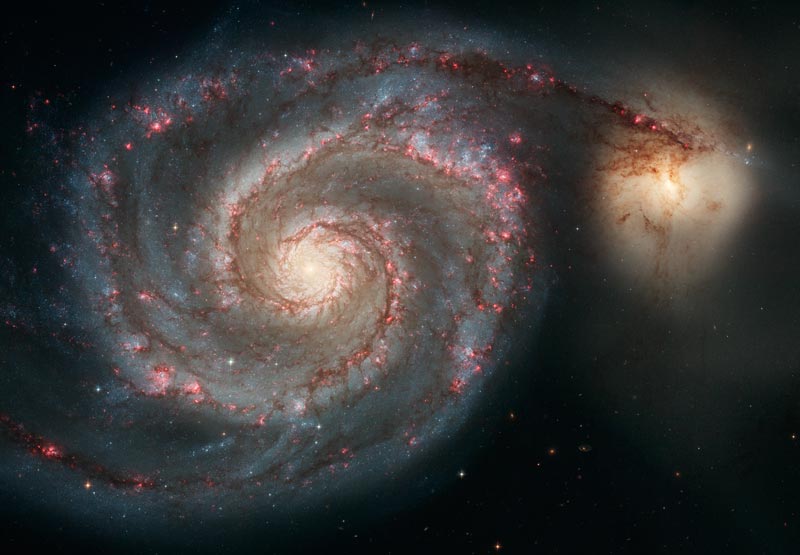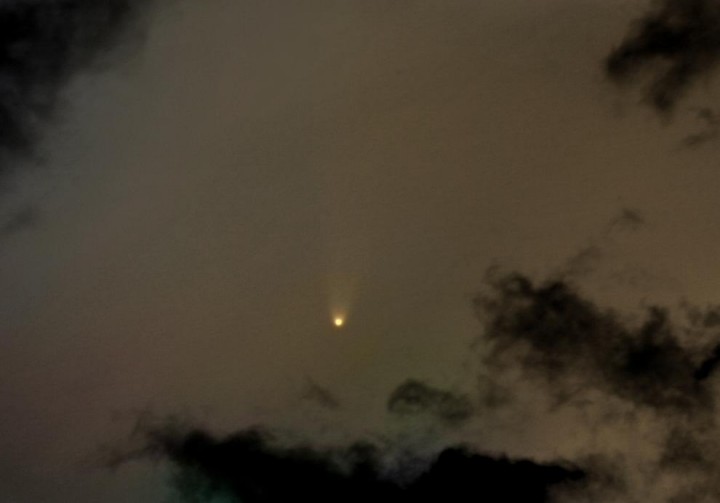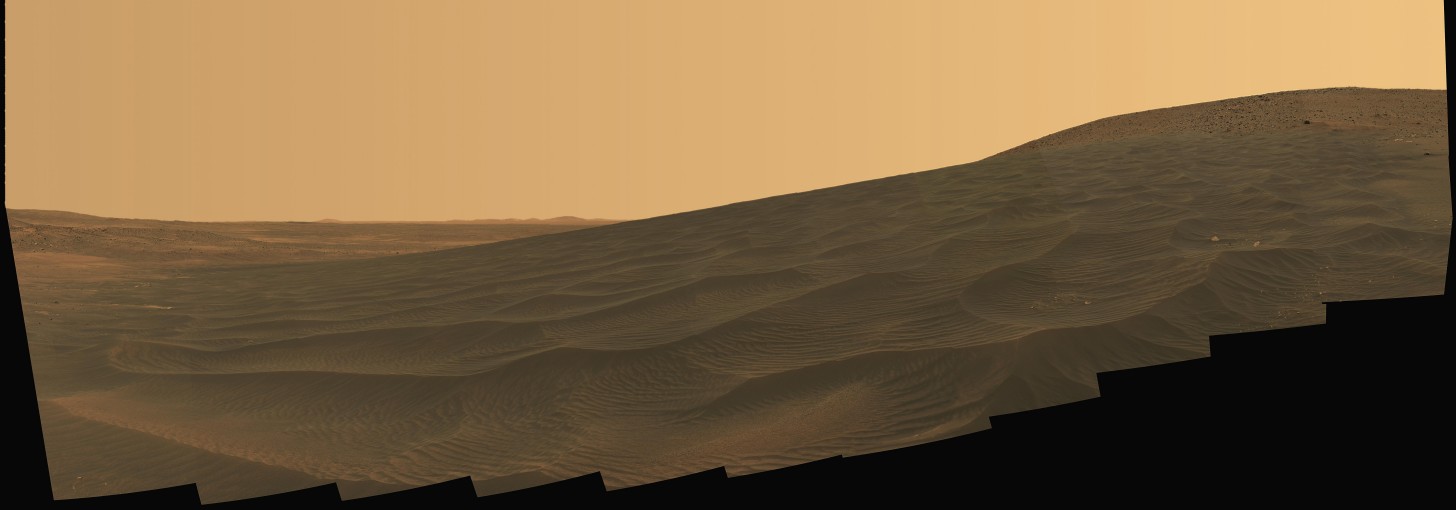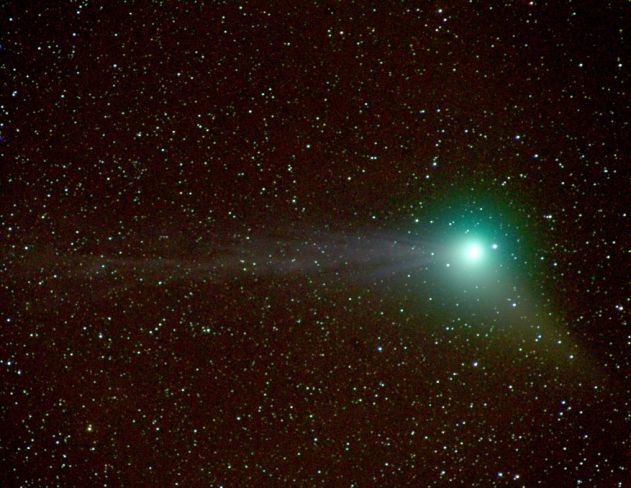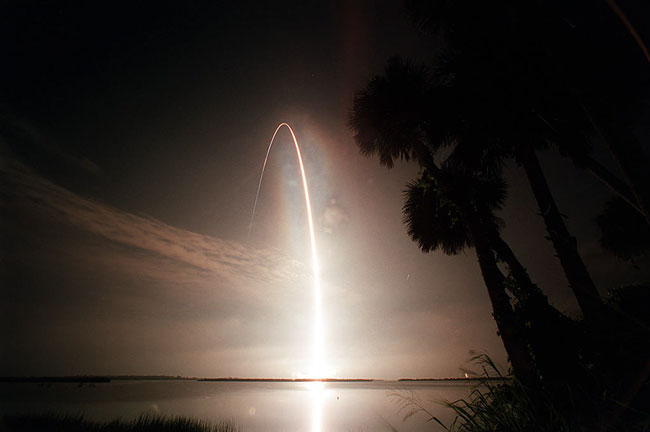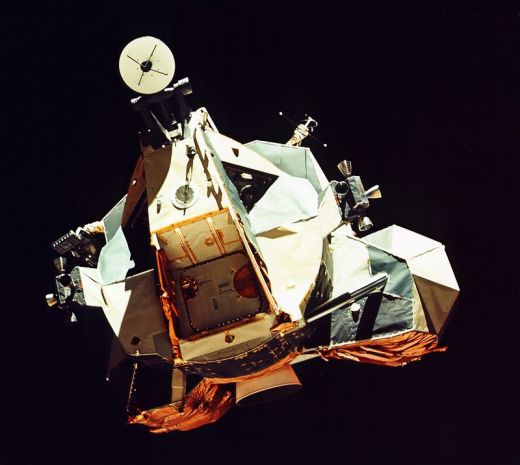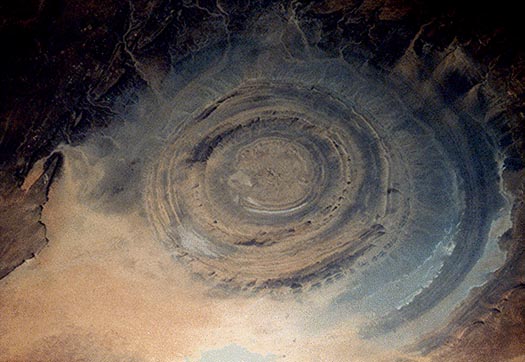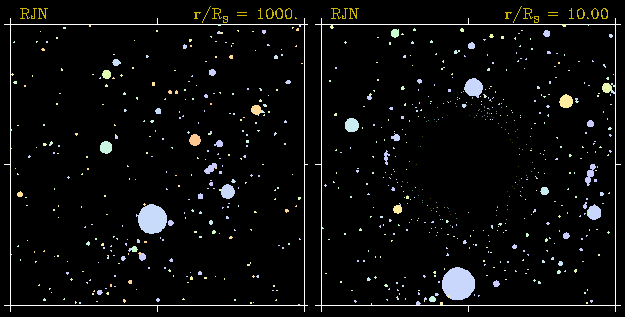| << Previous | Index | Next >> |
2015 What do the following things have in common: a cone, the fur of a fox, and a Christmas tree? Answer: they all occur in the constellation of the unicorn (Monoceros). Pictured as a star forming region and cataloged as NGC 2264, the complex jumble of cosmic gas and dust is about 2,700 light-years distant and mixes reddish emission nebulae excited by energetic light from newborn stars with dark interstellar dust clouds. Where the otherwise obscuring dust clouds lie close to the hot, young stars they also reflect starlight, forming blue reflection nebulae. The image spans about the diameter of a full moon, covering about 30 light-years at the distance of NGC 2264. Its cast of cosmic characters includes the Fox Fur Nebula, whose convoluted pelt lies on the lower right, bright variable star S Mon visible just above the Fox Fur, and the Cone Nebula on the image left. Given their distribution, the stars of NGC 2264 are also known as the Christmas Tree star cluster. The triangular tree shape traced by the stars appears here with its apex at the Cone Nebula on the left with its broader base near S Mon on the right.
2014 What's happening to galaxy NGC 474? The multiple layers of emission appear strangely complex and unexpected given the relatively featureless appearance of the elliptical galaxy in less deep images. The cause of the shells is currently unknown, but possibly tidal tails related to debris left over from absorbing numerous small galaxies in the past billion years. Alternatively the shells may be like ripples in a pond, where the ongoing collision with the spiral galaxy just above NGC 474 is causing density waves to ripple though the galactic giant. Regardless of the actual cause, the above image dramatically highlights the increasing consensus that at least some elliptical galaxies have formed in the recent past, and that the outer halos of most large galaxies are not really smooth but have complexities induced by frequent interactions with -- and accretions of -- smaller nearby galaxies. The halo of our own Milky Way Galaxy is one example of such unexpected complexity. NGC 474 spans about 250,000 light years and lies about 100 million light years distant toward the constellation of the Fish (Pisces).
2013 Get out your red/blue glasses and float next to Helene, small, icy moon of Saturn. Appropriately named, Helene is one of four known Trojan moons, so called because it orbits at a Lagrange point. A Lagrange point is a gravitationally stable position near two massive bodies, in this case Saturn and larger moon Dione. In fact, irregularly shaped ( about 36 by 32 by 30 kilometers) Helene orbits at Dione's leading Lagrange point while brotherly ice moon Polydeuces follows at Dione's trailing Lagrange point. The sharp stereo anaglyph was constructed from two Cassini images (N00172886, N00172892) captured during a close flyby in 2011. It shows part of the Saturn-facing hemisphere of Helene mottled with craters and gully-like features.
2012 Orbiting in the plane of Saturn's rings, Saturnian moons have a perpetual ringside view of the gorgeous gas giant planet. Of course, while passing near the ring plane the Cassini spacecraft also shares their stunning perspective. The rings themselves can be seen slicing across the middle of this Cassini snapshot from May of last year. The scene features Titan, largest, and Dione, third largest moon of Saturn. Remarkably thin, the bright rings still cast arcing shadows across the planet's cloud tops at the bottom of the frame. Pale Dione is about 1,100 kilometers across and orbits over 300,000 kilometers from the visible outer edge of the A ring. Dione is seen through Titan's atmospheric haze. At 5,150 kilometers across, Titan is about 2.3 million kilometers from Cassini, while Dione is 3.2 million kilometers away.
2011 Skywatchers throughout much of Europe, North Africa, and Central Asia, were treated to the first eclipse of the new year on January 4, a partial eclipse of the Sun. But traveling to the area around Muscat, capital city of Oman, photographer Thierry Legault planned to simultaneously record two eclipses on that date, calculating from that position, for a brief moment, both the Moon and the International Space Station could be seen in silhouette, crossing the Sun. His sharp, 1/5000th second exposure is shown here, capturing planet Earth's two largest satellites against the bright solar disk. As the partial solar eclipse unfolded, the space station (above and left of center) zipped across the scene in less than 1 second, about 500 kilometers from the photographer's telescope and camera. Of course, the Moon was 400 thousand kilometers away. Complete with sunspots, the Sun was 150 million kilometers distant.
2010 What kind of cloud is this? A roll cloud. These rare long clouds may form near advancing cold fronts. In particular, a downdraft from an advancing storm front can cause moist warm air to rise, cool below its dew point, and so form a cloud. When this happens uniformly along an extended front, a roll cloud may form. Roll clouds may actually have air circulating along the long horizontal axis of the cloud. A roll cloud is not thought to be able to morph into a tornado. Unlike a similar shelf cloud, a roll cloud, a type of Arcus cloud, is completely detached from their parent cumulonimbus cloud. Pictured above, a roll cloud extends far into the distance in 2009 January above Las Olas Beach in Maldonado, Uruguay.
2009 This meteor streaking toward the horizon through the early morning sky of January 4th is from the annual Quadrantid meteor shower. Aligned with the shower's radiant point high in the north (off the top of the view), the meteor trail passes to the right of bright bluish star Beta Scorpii. Remarkably, near the top of the trail is a small spot, the fuzzy greenish glow of a comet. Discovered in July of 2007, Comet Lulin (C/2007 N3), is too faint now to be easily seen by the unaided eye, but will likely brighten to become visible to skygazers by late February. The well-timed skyscape featuring both comet and meteor is particularly appropriate as cometary bodies are known to be the origins of planet Earth's annual meteor showers.
2008 Follow the handle of the Big Dipper away from the dipper's bowl, until you get to the handle's last bright star. Then, just slide your telescope a little south and west and you might find this stunning pair of interacting galaxies, the 51st entry in Charles Messier's famous catalog. Perhaps the original spiral nebula, the large galaxy with well defined spiral structure is also cataloged as NGC 5194. Its spiral arms and dust lanes clearly sweep in front of its companion galaxy (right), NGC 5195. The pair are about 31 million light-years distant and officially lie within the boundaries of the small constellation Canes Venatici. Though M51 looks faint and fuzzy in small, earthbound telescopes, this sharpest ever picture of M51 was made in January 2005 with the Advanced Camera for Surveys on board the Hubble Space Telescope.
2007 Early morning risers with a clear and unobstructed eastern horizon can enjoy the sight of Comet McNaught (C/2006 P1) in dawn skies over the next few days. Discovered in August by R. H. McNaught (Siding Spring Survey) the comet has grown bright enough to see with the unaided eye but will soon be lost in the glare of the Sun. Still, by January 11 sun-staring spacecraft SOHO should be able to offer web-based views as the comet heads toward a perihelion passage inside the orbit of Mercury. This image captures the new naked-eye comet at about 2nd magnitude in twilight skies near sunset on January 3rd. After rounding the Sun and emerging from the solar glare later this month, Comet McNaught could be even brighter.
2006 According to an Earth-based calendar, the Spirit rover spent the first day of 2006 gathering data to complete this panoramic view from Gusev crater on Mars. That day corresponded to Spirit's 710th Martian day or sol on the Red Planet. Scrolling right the view spans 160 degrees, looking up a slope and across rippled sand deposits in a dark field dubbed "El Dorado". The Spirit rover is traveling in a down hill direction after reaching the summit of Husband Hill. This month, both Spirit and Opportunity rovers will celebrate two years of Mars exploration, a remarkable achievement considering their original 90 day warranty. During that time Spirit has traveled over 3.5 miles and Opportunity over 4 miles across the Martian surface.
2005 Good views of Comet Machholz are in store for northern hemisphere comet watchers in January. Now making its closest approach to planet Earth, the comet will pass near the lovely Pleiades star cluster on January 7th and the double star cluster in Perseus on January 27th as Machholz moves relatively quickly through the evening sky. Currently just visible to the unaided eye from dark locations, the comet should be an easy target in binoculars or a small telescope. In fact, this telephoto time exposure from January 1 shows Comet Machholz sporting two lovely tails in skies over Colorado, USA. Extending to the left, strands of the comet's ion or gas tail are readily affected by the solar breeze and point away from the Sun. Dust, which tends to trail along the comet's orbit, forms the tail jutting down and to the right.
2004 After a seven month voyage of nearly 500 million kilometers through interplanetary space, NASA's Spirit Rover has reached the surface of Mars. Scroll right and see a mosaic panorama of Spirit's first images returned from its landing site in Gusev Crater! Taken by Spirit's navigation camera, the panorama covers 360 degrees, with the spacecraft in the foreground and the floor of Gusev Crater, thought to be an ancient lake bed, extending to the horizon. The entry, descent, and landing phase of Spirit's mission - referred to by mission planners as "Six Minutes of Terror" - began Saturday night around 8:30pm PST as Spirit entered the martian atmosphere at about 20,000 kilometers per hour. Updates on Spirit's status will be posted throughout the day.
2003 Birds don't fly this high. Airplanes don't go this fast. The Statue of Liberty weighs less. No species other than human can even comprehend what is going on, nor could any human just a millennium ago. The launch of a rocket bound for space is an event that inspires awe and challenges description. Pictured above, the Space Shuttle Atlantis lifted off to visit the International Space Station during the early morning hours of July 12. From a standing start, the two million kilogram rocket ship left to circle the Earth where the outside air is too thin to breathe and where there is little noticeable onboard gravity. Rockets bound for space are now launched from somewhere on Earth about once a week.
2002 Awkward and angular looking, Apollo 17's lunar module Challenger was designed for flight in the vacuum of space. This sharp picture from the command module America, shows Challenger's ascent stage in lunar orbit. Small reaction control thrusters are at the sides of the moonship with the bell of the ascent rocket engine itself underneath. The hatch allowing access to the lunar surface is visible in the front and a round radar antenna appears at the top. This spaceship performed gracefully, landing on the moon and returning the Apollo astronauts to the orbiting command module in December of 1972 - but where is Challenger now? Its descent stage remains at the Apollo 17 landing site, Taurus-Littrow. The ascent stage was intentionally crashed nearby after being jettisoned from the command module prior to the astronauts' return to planet Earth. Apollo 17's mission was the sixth and last time astronauts have landed on the moon.
Editor's note: Eric Jones, Apollo Lunar Surface Journal editor, comments; "If you look at the [... large, dark] triangular window, you'll see a bright rectangular area - which is the rendezvous window - beneath it, a bright arc. After much discussion, my team of volunteers and I concluded that the bright arc is the top of [mission commander] Gene Cernan's bubble helmet lit by sunlight ..."
2001 Christmas Day 2000 featured the final eclipse of the Second Millennium -- a partial solar eclipse visible from much of North America. Astrophotographer Phil Rau recorded the entire event on a single image as the Sun and Moon arced through winter skies above Cary, North Carolina, USA. Using a well positioned, tripod mounted camera and a solar filter, Rau made a short exposure every 10 minutes from 11:00 am to 1:30 pm EST, covering the local duration of the eclipse. The resulting image beautifully illustrates the steady progress of the dark new Moon as it appears to take a bite out of the golden solar disk. From his location, at eclipse maximum (near picture center) just less than 50 percent of the Sun's diameter was covered by the Moon.
2000 The Space Shuttle Discovery Crew was fortunate enough to witness one of the brighter full moon's from orbit two weeks ago during their mission to fix the Hubble Space Telescope. Pictured on the left, the horizon of the Earth is visible below this full Moon, which is below the edge of the Hubble Space Telescope. The full Moon on this day, last December 22, was a few percent brighter than average because it was full at nearly the same time it was at its closest to the Earth, which comes at a time when the Earth is relatively close to the Sun. The Shuttle Crew successfully showered Hubble with needed holiday gifts, including six new gyroscopes, a new computer, and new batteries.
1999 Even Jupiter can do the twist. Large cloud systems on Jupiter rotate, and the newly formed oval pictured above is no different. This new oval formed earlier this year from the collision of two smaller ovals: an occurrence not unlike two large storms merging into one huge hurricane. Even this new swirling storm, however, is small compared to Jupiter's Great Red Spot. The above-animated frame dithers between two pictures of the new oval taken roughly an hour apart. The Galileo spacecraft currently orbiting the giant Jovian planet captured the pictures.
1998 What on Earth is that? The Richat Structure in the Sahara Desert of Mauritania is easily visible from space because it is nearly 50 kilometers across. Once thought to be an impact crater, the Richat Structure's flat middle and lack of shock-altered rock indicates otherwise. The possibility that the Richat Structure was formed by a volcanic eruption also seems improbable because of the lack of a dome of igneous or volcanic rock. Rather, the layered sedimentary rock of the Richat structure is now thought by many to have been caused by uplifted rock sculpted by erosion. Why the Richat Structure is nearly circular remains a mystery.
1997 What would you see if you went right up to a black hole? Above are two computer generated pictures highlighting how strange things would look. On the left is a normal star field containing the constellation Orion. Notice the three stars of nearly equal brightness that make up Orion's Belt. On the right is the same star field but this time with a black hole superposed in the center of the frame. The black hole has such strong gravity that light is noticeably bent towards it - causing some very unusual visual distortion. In the distorted frame, every star in the normal frame has at least two bright images - one on each side of the black hole. In fact, near the black hole, you can see the whole sky - light from every direction is bent around and comes back to you. Black holes are thought to be the densest state of matter, and there is indirect evidence for their presence in stellar binary systems and the centers of globular clusters, galaxies, and quasars.
1996
| << Previous | Index | Next >> |
